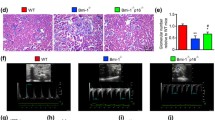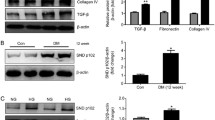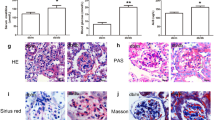Abstract
Human glomerular mesangial cells (HMCs) have a finite lifespan and eventually enter irreversible growth arrest known as cellular senescence which is thought to contribute to kidney aging and age-related kidney disorders, such as chronic kidney disease. The signal transducer and activator of transcription 1 (STAT1) is a latent transcription factor involved in a variety of signal transduction pathways, including cell proliferation, apoptosis, and differentiation, but whether it could regulate HMCs senescence still remains to be explored. In our study, induction of Angiotensin II (Ang II) and H2O2 accelerated premature senescence of HMCs as confirmed by increased senescence-associated -β-galactosidase (SA-β-gal) positive staining cells and G0/G1 cell cycle arrest. The STAT1 and STAT3 activity and the expression of p53 and p21Cip1 were increased after Angiotensin II and H2O2 treatment. Knockdown STAT1 using RNA interference significantly attenuated the progression of HMCs senescence, decreased the elevated p53 and p21Cip1, more interestingly, STAT3 and its activity was further enhanced while STAT1 was silenced. Our results indicate that STAT1 might mediate Ang II and H2O2-induced HMCs senescence through p53/p21Cip1 pathway and the relative abundance of STAT1 and STAT3.





Similar content being viewed by others
References
Sampson MJ, Hughes DA (2006) Chromosomal telomere attrition as a mechanism for the increased risk of epithelial cancers and senescent phenotypes in type 2 diabetes. Diabetologia 49:1726–1731
Sampson MJ, Winterbone MS, Hughes JC, Dozio N, Hughes DA (2006) Monocyte telomere shortening and oxidative DNA damage in type 2 diabetes. Diabetes Care 29:283–289
Ben-Porath I, Weinberg RA (2004) When cells get stressed: an integrative view of cellular senescence. J Clin Invest 113:8–13
Itahana K, Campisi J, Dimri GP (2007) Methods to detect biomarkers of cellular senescence: the senescence-associated beta-galactosidase assay. Methods Mol Biol 371:21–31
Melk A, Ramassar V, Helms LM, Moore R, Rayner D, Solez K, Halloran PF (2000) Telomere shortening in kidneys with age. J Am Soc Nephrol (JASN) 11:444–453
Vaux DL, Strasser A (1996) The molecular biology of apoptosis. Proc Natl Acad Sci USA 93:2239–2244
Mukai Y, Shimokawa H, Higashi M, Morikawa K, Matoba T, Hiroki J, Kunihiro I, Talukder HM, Takeshita A (2002) Inhibition of renin-angiotensin system ameliorates endothelial dysfunction associated with aging in rats. Arterioscler Thromb Vasc Biol 22:1445–1450
Kansui Y, Fujii K, Goto K, Abe I, Iida M (2002) Angiotensin II receptor antagonist improves age-related endothelial dysfunction. J Hypertens 20:439–446
Imanishi T, Kobayashi K, Kuroi A, Ikejima H, Akasaka T (2008) Pioglitazone inhibits angiotensin II-induced senescence of endothelial progenitor cell. Hypertens Res 31:757–765
Shan H, Bai X, Chen X (2008) Angiotensin II induces endothelial cell senescence via the activation of mitogen-activated protein kinases. Cell Biochem Funct 26:459–466
Herbert KE, Mistry Y, Hastings R, Poolman T, Niklason L, Williams B (2008) Angiotensin II-mediated oxidative DNA damage accelerates cellular senescence in cultured human vascular smooth muscle cells via telomere-dependent and independent pathways. Circ Res 102:201–208
Imanishi T, Hano T, Nishio I (2005) Angiotensin II accelerates endothelial progenitor cell senescence through induction of oxidative stress. J Hypertens 23:97–104
Schindler C, Levy DE, Decker T (2007) JAK-STAT signaling: from interferons to cytokines. J Biol Chem 282:20059–20063
Levy DE, Darnell JE Jr (2002) Stats: transcriptional control and biological impact. Nat Rev Mol Cell Biol 3:651–662
Chin YE, Kitagawa M, Su WC, You ZH, Iwamoto Y, Fu XY (1996) Cell growth arrest and induction of cyclin-dependent kinase inhibitor p21 WAF1/CIP1 mediated by STAT1. Science 272:719–722
Dimberg A, Karlberg I, Nilsson K, Oberg F (2003) Ser727/Tyr701-phosphorylated Stat1 is required for the regulation of c-Myc, cyclins, and p27Kip1 associated with ATRA-induced G0/G1 arrest of U-937 cells. Blood 102:254–261
Xiao S, Li D, Zhu HQ, Song MG, Pan XR, Jia PM, Peng LL, Dou AX, Chen GQ, Chen SJ, Chen Z, Tong JH (2006) RIG-G as a key mediator of the antiproliferative activity of interferon-related pathways through enhancing p21 and p27 proteins. Proc Natl Acad Sci USA 103:16448–16453
Bernabei P, Coccia EM, Rigamonti L, Bosticardo M, Forni G, Pestka S, Krause CD, Battistini A, Novelli F (2001) Interferon-gamma receptor 2 expression as the deciding factor in human T, B, and myeloid cell proliferation or death. J Leukoc Biol 70:950–960
Hubackova S, Novakova Z, Krejcikova K, Kosar M, Dobrovolna J, Duskova P, Hanzlikova H, Vancurova M, Barath P, Bartek J, Hodny Z (2010) Regulation of the PML tumor suppressor in drug-induced senescence of human normal and cancer cells by JAK/STAT-mediated signaling. Cell cycle 9:3085–3099
Wang TL, Yang YH, Chang H, Hung CR (2004) Angiotensin II signals mechanical stretch-induced cardiac matrix metalloproteinase expression via JAK-STAT pathway. J Mol Cell Cardiol 37:785–794
Banes-Berceli AK, Shaw S, Ma G, Brands M, Eaton DC, Stern DM, Fulton D, Caldwell RW, Marrero MB (2006) Effect of simvastatin on high glucose- and angiotensin II-induced activation of the JAK/STAT pathway in mesangial cells. Am J Physiol 291:F116–F121
Wang XD, Chen XM, Wang JZ, Hong Q, Feng Z, Fu B, Zhou F, Wang FY, Fan DM (2006) Signal transducers and activators of transcription 3 mediates up-regulation of angiotensin II-induced tissue inhibitor of metalloproteinase-1 expression in cultured human senescent fibroblasts. Chin Med J 119:1094–1102
Amiri F, Shaw S, Wang X, Tang J, Waller JL, Eaton DC, Marrero MB (2002) Angiotensin II activation of the JAK/STAT pathway in mesangial cells is altered by high glucose. Kidney Int 61:1605–1616
Madamanchi NR, Li S, Patterson C, Runge MS (2001) Reactive oxygen species regulate heat-shock protein 70 via the JAK/STAT pathway. Arterioscler Thromb Vasc Biol 21:321–326
Gorina R, Sanfeliu C, Galito A, Messeguer A, Planas AM (2007) Exposure of glia to pro-oxidant agents revealed selective Stat1 activation by H2O2 and Jak2-independent antioxidant features of the Jak2 inhibitor AG490. Glia 55:1313–1324
Zhou H, Huang B, Du J, Wang L (2010) Role of the JAK2/STAT pathway and losartan in human glomerular mesangial cell senescence. Mol Med Rep 3:393–398
Dimri GP, Lee X, Basile G, Acosta M, Scott G, Roskelley C, Medrano EE, Linskens M, Rubelj I, Pereira-Smith O et al (1995) A biomarker that identifies senescent human cells in culture and in aging skin in vivo. Proc Natl Acad Sci USA 92:9363–9367
Zhang X, Chen X, Wu D, Liu W, Wang J, Feng Z, Cai G, Fu B, Hong Q, Du J (2006) Downregulation of connexin 43 expression by high glucose induces senescence in glomerular mesangial cells. J Am Soc Nephrol 17:1532–1542
Chen QM, Bartholomew JC, Campisi J, Acosta M, Reagan JD, Ames BN (1998) Molecular analysis of H2O2-induced senescent-like growth arrest in normal human fibroblasts: p53 and Rb control G1 arrest but not cell replication. Biochem J 332(Pt 1):43–50
Lin AW, Barradas M, Stone JC, van Aelst L, Serrano M, Lowe SW (1998) Premature senescence involving p53 and p16 is activated in response to constitutive MEK/MAPK mitogenic signaling. Genes Dev 12:3008–3019
Hale AJ, Smith CA, Sutherland LC, Stoneman VE, Longthorne VL, Culhane AC, Williams GT (1996) Apoptosis: molecular regulation of cell death. Eur J Biochem 236:1–26
Muller M (2009) Cellular senescence: molecular mechanisms, in vivo significance, and redox considerations. Antioxid Redox Signal 11:59–98
Chen QM, Liu J, Merrett JB (2000) Apoptosis or senescence-like growth arrest: influence of cell-cycle position, p53, p21 and bax in H2O2 response of normal human fibroblasts. Biochem J 347:543–551
Hunter T (1993) Braking the cycle. Cell 75:839–841
Sherr CJ, Roberts JM (1995) Inhibitors of mammalian G1 cyclin-dependent kinases. Genes Dev 9:1149–1163
Luo Y, Hurwitz J, Massague J (1995) Cell-cycle inhibition by independent CDK and PCNA binding domains in p21Cip1. Nature 375:159–161
Chang BD, Xuan Y, Broude EV, Zhu H, Schott B, Fang J, Roninson IB (1999) Role of p53 and p21waf1/cip1 in senescence-like terminal proliferation arrest induced in human tumor cells by chemotherapeutic drugs. Oncogene 18:4808–4818
David M, Petricoin E 3rd, Benjamin C, Pine R, Weber MJ, Larner AC (1995) Requirement for MAP kinase (ERK2) activity in interferon alpha- and interferon beta-stimulated gene expression through STAT proteins. Science 269:1721–1723
Kovarik P, Mangold M, Ramsauer K, Heidari H, Steinborn R, Zotter A, Levy DE, Muller M, Decker T (2001) Specificity of signaling by STAT1 depends on SH2 and C-terminal domains that regulate Ser727 phosphorylation, differentially affecting specific target gene expression. EMBO J 20:91–100
Kim HS, Lee MS (2007) STAT1 as a key modulator of cell death. Cell Signal 19:454–465
Agrawal S, Agarwal ML, Chatterjee-Kishore M, Stark GR, Chisolm GM (2002) Stat1-dependent, p53-independent expression of p21(waf1) modulates oxysterol-induced apoptosis. Mol Cell Biol 22:1981–1992
Xu X, Fu XY, Plate J, Chong AS (1998) IFN-gamma induces cell growth inhibition by Fas-mediated apoptosis: requirement of STAT1 protein for up-regulation of Fas and FasL expression. Cancer Res 58:2832–2837
Townsend PA, Scarabelli TM, Davidson SM, Knight RA, Latchman DS, Stephanou A (2004) STAT-1 interacts with p53 to enhance DNA damage-induced apoptosis. J Biol Chem 279:5811–5820
Dimco G, Knight RA, Latchman DS, Stephanou A (2010) STAT1 interacts directly with cyclin D1/Cdk4 and mediates cell cycle arrest. Cell cycle 9:4638–4649
Costa-Pereira AP, Tininini S, Strobl B, Alonzi T, Schlaak JF, Is’harc H, Gesualdo I, Newman SJ, Kerr IM, Poli V (2002) Mutational switch of an IL-6 response to an interferon-gamma-like response. Proc Natl Acad Sci USA 99:8043–8047
Qing Y, Stark GR (2004) Alternative activation of STAT1 and STAT3 in response to interferon-gamma. J Biol Chem 279:41679–41685
Shen Y, Devgan G, Darnell JE Jr, Bromberg JF (2001) Constitutively activated Stat3 protects fibroblasts from serum withdrawal and UV-induced apoptosis and antagonizes the proapoptotic effects of activated Stat1. Proc Natl Acad Sci USA 98:1543–1548
Bromberg J (2002) Stat proteins and oncogenesis. J Clin Invest 109:1139–1142
Barre B, Avril S, Coqueret O (2003) Opposite regulation of myc and p21waf1 transcription by STAT3 proteins. J Biol Chem 278:2990–2996
Giraud S, Bienvenu F, Avril S, Gascan H, Heery DM, Coqueret O (2002) Functional interaction of STAT3 transcription factor with the coactivator NcoA/SRC1a. J Biol Chem 277:8004–8011
Tsirpanlis G, Chatzipanagiotou S, Boufidou F, Kordinas V, Zoga M, Alevyzaki F, Stamatelou K, Frangou E, Savva L, Nicolaou C (2006) Serum oxidized low-density lipoprotein is inversely correlated to telomerase activity in peripheral blood mononuclear cells of haemodialysis patients. Nephrology 11:506–509
Lai SR, Cunningham AP, Huynh VQ, Andrews LG, Tollefsbol TO (2007) Evidence of extra-telomeric effects of hTERT and its regulation involving a feedback loop. Exp Cell Res 313:322–330
Perrault SD, Hornsby PJ, Betts DH (2005) Global gene expression response to telomerase in bovine adrenocortical cells. Biochem Biophys Res Commun 335:925–936
Acknowledgment
This study was supported by a grant from the Major Basic Project of China (973), No.2007CB507400. The authors thank the central laboratory of First Hospital of China Medical University for valuable suggestions and help.
Author information
Authors and Affiliations
Corresponding author
Rights and permissions
About this article
Cite this article
Jiao, S., Meng, F., Zhang, J. et al. STAT1 mediates cellular senescence induced by angiotensin II and H2O2 in human glomerular mesangial cells. Mol Cell Biochem 365, 9–17 (2012). https://doi.org/10.1007/s11010-011-1197-3
Received:
Accepted:
Published:
Issue Date:
DOI: https://doi.org/10.1007/s11010-011-1197-3




